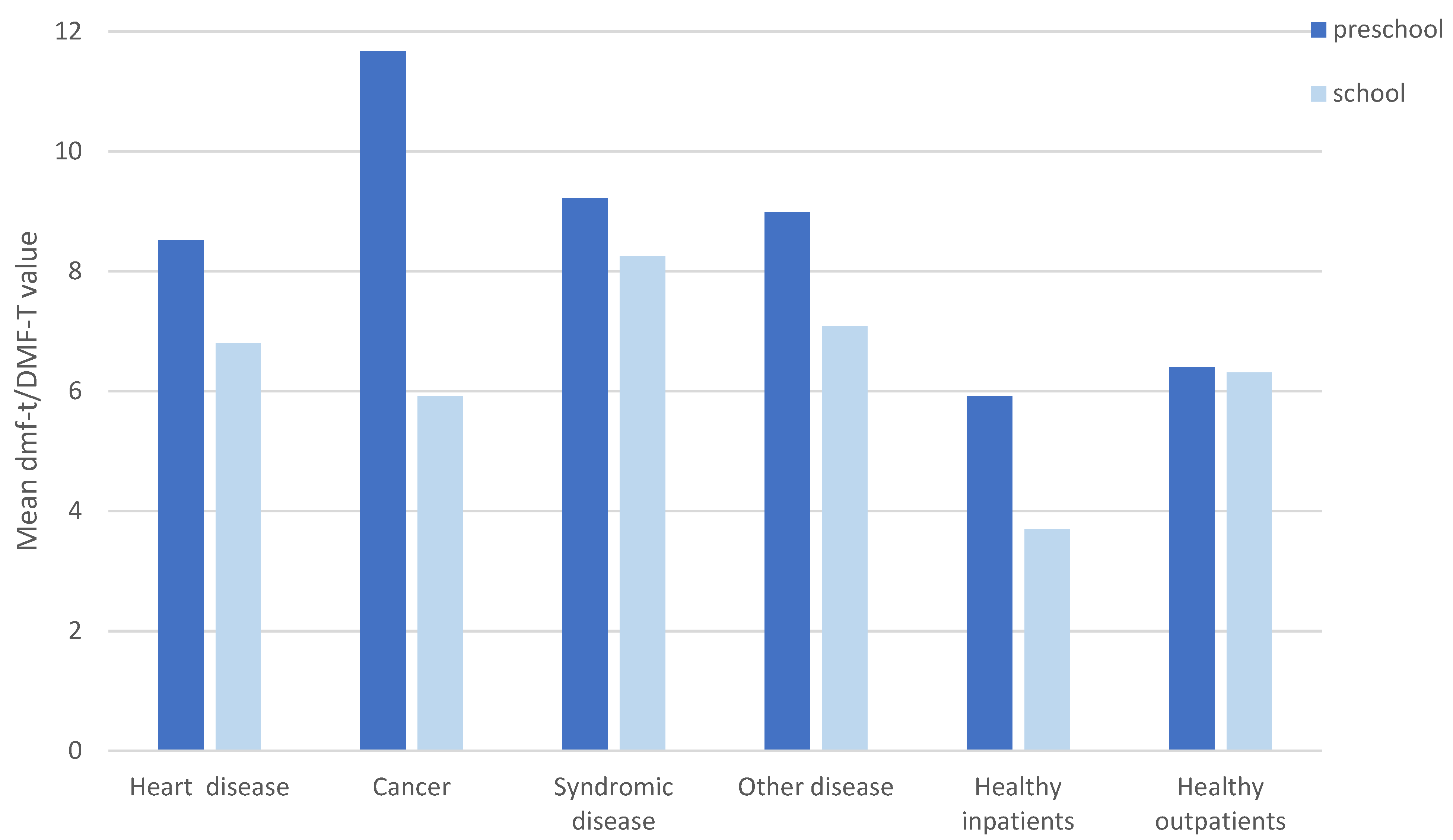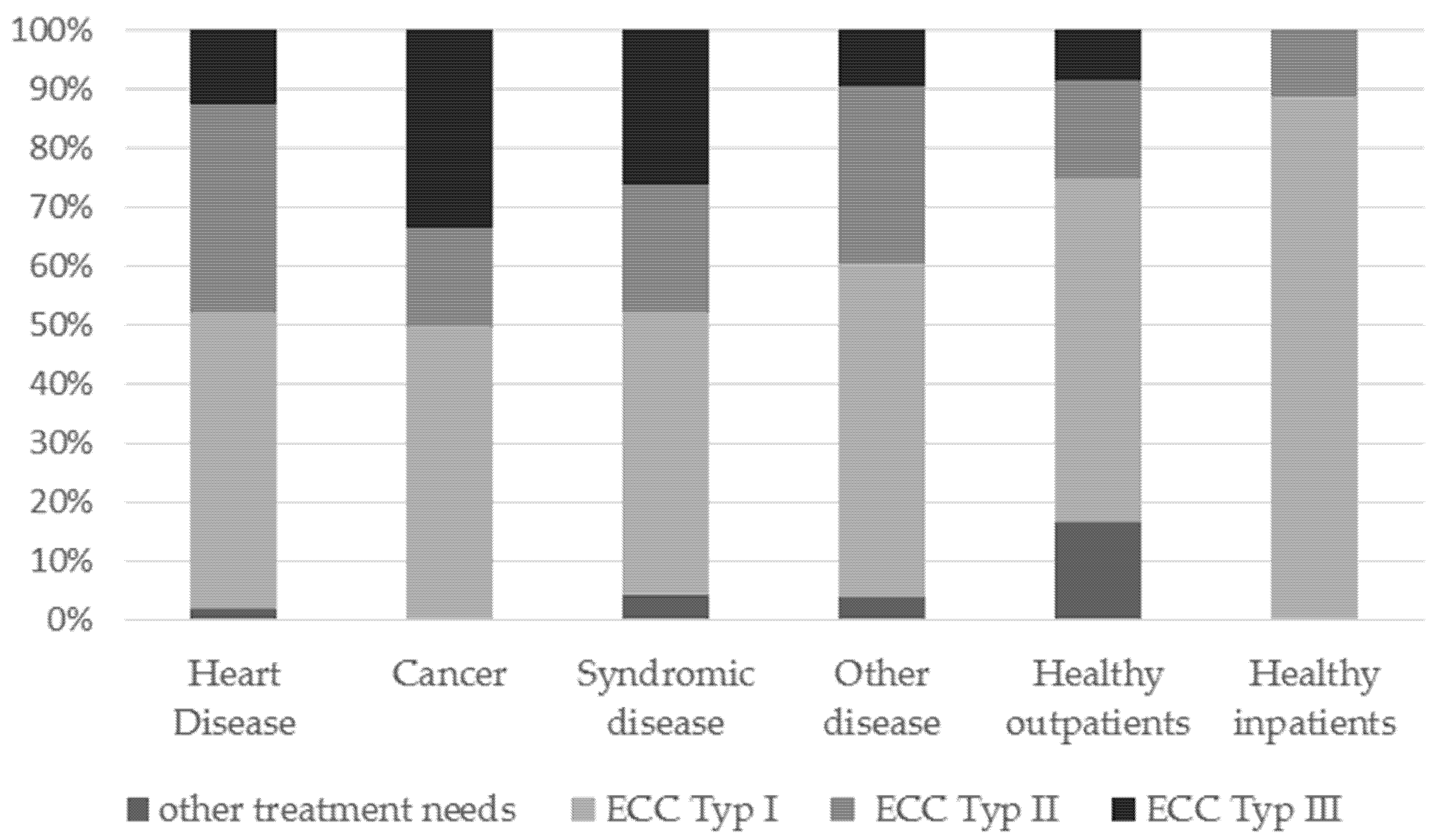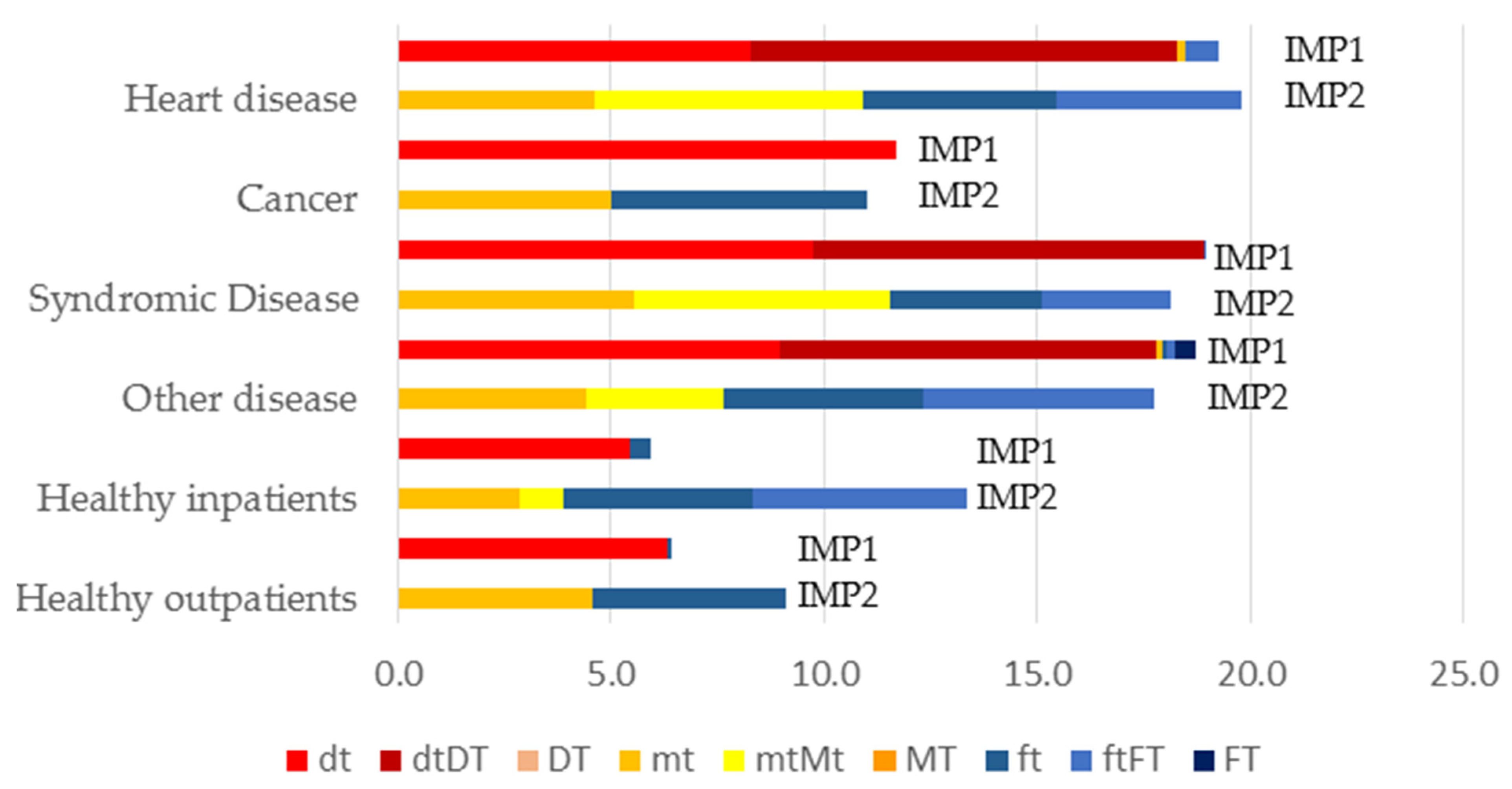Dental Treatment under General Anesthesia in Pre-School Children and Schoolchildren with Special Healthcare Needs: A Comparative Retrospective Study
Abstract
1. Introduction
- (1)
- There is no association between caries experience (dmf-t/DMF-T, SiC and CRI) and pre-existing cofactors.
- (2)
- There is no difference in waiting time regarding pre-existing cofactor.
- (3)
- There is no difference in terms of dental treatment in all groups.
2. Materials and Methods
2.1. Subjects and Setting
2.2. Data Collection
2.3. Statistical Analysis
3. Results
3.1. Caries Experience
3.2. Dental Treatment under General Anesthesia
3.2.1. Waiting Time
3.2.2. Dental Procedures in GA Patients
4. Discussion
5. Conclusions
Author Contributions
Funding
Institutional Review Board Statement
Informed Consent Statement
Data Availability Statement
Acknowledgments
Conflicts of Interest
References
- Jordan, R.A.; Bodechtel, C.; Hertrampf, K.; Hoffmann, T.; Kocher, T.; Nitschke, I.; Schiffner, U.; Stark, H.; Zimmer, S.; Micheelis, W.; et al. The fifth German oral health study (Fünfte Deutsche Mundgesundheitsstudie, DMS V)—Rationale, design, and methods. BMC Oral Health 2014, 14, 161. [Google Scholar] [CrossRef] [PubMed]
- Pieper, K.; Lange, J.; Jablonski-Momeni, A.; Schulte, A.G. Caries prevalence in 12-year-old children from Germany: Results of the 2009 national survey. Commun. Dent. Health 2013, 30, 138–142. [Google Scholar]
- Pieper, K.; Schulte, A.G. The decline in dental caries among 12-year-old children in Germany between 1994 and 2000. Commun. Dent. Health 2004, 21, 199–206. [Google Scholar]
- Schulte, A.G.; Momeni, A.; Pieper, K. Caries prevalence in 12-year-old children from Germany. Results of the 2004 national survey. Commun. Dent. Health 2006, 23, 197–202. [Google Scholar]
- Schmoeckel, J.; Santamaría, R.M.; Basner, R.; Schankath, E.; Splieth, C.H. Mundgesundheitstrends im Kindesalter. Bundesgesundheitsblatt–Gesundheitsforschung–Gesundheitsschutz 2021, 64, 772–781. [Google Scholar] [CrossRef]
- Schulte, A.G.; Freyer, K.; Bissar, A. Caries experience and treatment need in adults with intellectual disabilities in two German regions. Commun. Dent. Health 2013, 13, 39–44. [Google Scholar]
- Shyama, M.; Al-Mutawa, S.A.; Morris, R.E.; Sugathan, T. Dental caries experience of disabled children and young adults in Kuwait. Commun. Dent. Health 2001, 18, 181–186. [Google Scholar]
- Busenhart, D.M.; Erb, J.; Rigakos, G.; Eliades, T.; Papageorgiou, S.N. Adverse effects of chemotherapy on the teeth and surrounding tissues of children with cancer: A systematic review with meta-analysis. Oral Oncol. 2018, 83, 64–72. [Google Scholar] [CrossRef]
- Schulz-Weidner, N.; Bulski, J.C.; Siahi-Benlarbi, R.; Bauer, J.; Logeswaran, T.; Jux, C.; Wetzel, W.; Krämer, N. Symptom-orientated oral hygiene for children after heart transplantation: Effectiveness of a standardized prophylactic program. Pediatr. Transpl. 2020, 24, e13845. [Google Scholar] [CrossRef]
- Lewis, C.; Robertson, A.S.; Phelps, S. Unmet dental care needs among children with special health care needs: Implications for the medical home. Pediatrics 2005, 116, e426–e431. [Google Scholar] [CrossRef]
- Pehlivan, B.; Duran, E.; Filazi, K.B.; Pehlivan, V.F. Analysis of paediatric dentistry cases operated under general anaesthesia: Is the number of operating rooms sufficient for dental general anaesthesia? Med. Sci. Discov. 2022, 9, 50–55. [Google Scholar] [CrossRef]
- Bratthall, D. Introducing the significant caries index together with a proposal for a new global oral health goal for 12-year-olds. Int. Dent. J. 2000, 50, 378–384. [Google Scholar] [CrossRef] [PubMed]
- Steegmann, C.; Pratsch, P.; Effenberger, S.; Schiffner, U. Caries in 3- to 6-year-old pre-school children in Hamburg. Caries Res. 2008, 42, 199. [Google Scholar]
- Mota-Veloso, I.; Soares, M.E.C.; Alencar, B.M.; Marques, L.S.; Ramos-Jorge, M.L.; Ramos-Jorge, J. Impact of untreated dental caries and its clinical consequences on the oral health-related quality of life of schoolchildren aged 8–10 years. Qual. Life Res. 2016, 25, 193–199. [Google Scholar] [CrossRef]
- Hayden, C.; Bowler, J.O.; Chambers, S.; Freeman, R.; Humphris, G.M.; Richards, D.; Cecil, J. Obesity and dental caries in children: A systematic review and meta-analysis. Commun. Dent. Oral Epidemiol. 2013, 41, 289–308. [Google Scholar] [CrossRef] [PubMed]
- Nitzsche, G. Frühkindliche Karies (ECC) sowie deren Therapie. Sonderbeilage Zahnärzteblatt Sachsen 2011, 6, 9–13. [Google Scholar]
- Norderyd, J.; Klingberg, G.; Faulks, D.; Granlund, M. Specialised dental care for children with complex disabilities focusing on child’s functioning and need for general anaesthesia. Disabil. Rehabil. 2017, 39, 2484–2491. [Google Scholar] [CrossRef]
- Leagault, J.V.; Diner, M.H.; Auger, R. Dental treatment of children in a general anaesthesia clinic: Review of 300 cases. J. Can. Dent. Assoc. 1972, 38, 221–224. [Google Scholar]
- Savanheimo, N.; Vehkalahti, M.M. Five-year follow-up of children receiving comprehensive dental care under general anesthesia. BMC Oral Health 2014, 14, 154. [Google Scholar] [CrossRef]
- Ramazani, N. Different aspects of general anesthesia in pediatric dentistry: A review. Iran. J. Pediatr. 2016, 26, e2613. [Google Scholar] [CrossRef]
- Tyrer, G.L. Referrals for dental general anaesthetics—How many really need GA? Br. Dent. J. 1999, 187, 440–443. [Google Scholar] [CrossRef] [PubMed]
- Nick, D.; Thompson, L.; Anderson, D.; Trapp, L. The use of general anesthesia to facilitate dental treatment. Gen. Dent. 2003, 51, 464–468, quiz 469. [Google Scholar] [PubMed]
- Lee, P.Y.; Chou, M.Y.; Chen, Y.L.; Chen, L.P.; Wang, C.J.; Huang, W.H. Comprehensive dental treatment under general anesthesia in healthy and disabled children. Chang Gung Med. J. 2009, 32, 636–642. [Google Scholar] [PubMed]
- Chen, Y.P.; Hsieh, C.Y.; Hsu, W.T.; Wu, F.Y.; Shih, W.Y. A 10-year trend of dental treatments under general anesthesia of children in Taipei Veterans General Hospital. J. Chin. Med. Assoc. 2017, 80, 262–268. [Google Scholar] [CrossRef]
- Schroth, R.J.; Quiñonez, C.; Shwart, L.; Wagar, B. Treating early childhood caries under general anesthesia: A national review of Canadian data. J. Can. Dent. Assoc. 2016, 82, 20. [Google Scholar]
- Alkilzy, M.; Qadri, G.; Horn, J.; Takriti, M.; Splieth, C. Referral patterns and general anesthesia in a specialized paediatric dental service. Int. J. Paediatr. Dent. 2015, 25, 204–212. [Google Scholar] [CrossRef]
- Guney, S.E.; Araz, C.; Tirali, R.E.; Cehreli, S.B. Dental anxiety and oral health-related quality of life in children following dental rehabilitation under general anesthesia or intravenous sedation: A prospective cross-sectional study. Niger. J. Clin. Pract. 2018, 21, 1304–1310. [Google Scholar]
- Manley, M.C.G.; Skelly, A.M.; Hamilton, A.G. Dental treatment for people with challenging behaviour: General anaesthesia or sedation? Br. Dent. J. 2000, 188, 358–660. [Google Scholar] [CrossRef][Green Version]
- Badre, B.; Serhier, Z.; El Arabi, S. Waiting times before dental care under general anesthesia in children with special needs in the Children’s Hospital of Casablanca. Pan Afr. Med. J. 2014, 17, 298. [Google Scholar] [CrossRef]
- Choi, J.; Doh, R.M. Dental treatment under general anesthesia for patients with severe disabilities. J. Dent. Anesth. Pain Med. 2021, 21, 87–98. [Google Scholar] [CrossRef]
- Hurwitz, E.E.; Simon, M.; Vinta, S.R.; Zehm, C.F.; Shabot, S.M.; Minhajuddin, A.; Abouleish, A.E. Adding examples to the ASA-physical status classification improves correct assignment to patients. Anesthesiology 2017, 126, 614–622. [Google Scholar] [CrossRef] [PubMed]
- Early Childhood Caries: IAPD Bangkok Declaration. Pediatr. Dent. 2019, 41, 176–178.
- World Health Organization. ICD-10: International Statistical Classification of Diseases and Related Health Problems: Tenth Revision, 2nd ed.; World Health Organization: Geneva, Switzerland, 2004. [Google Scholar]
- Pieper, K.; Blumenstein, A. Die Zahnmedizinische Untersuchung im Rahmen der Gruppenprophylaxe: Ein Leitfaden für die EDV-gestützte Erfolgskontrolle; Verlag Nicht Ermittelbar: Marburg, Germany, 1993; pp. 20–23. [Google Scholar]
- Schmoeckel, J.; Santamaría, R.M.; Basner, R.; Schüler, E.; Splieth, C.H. Introducing a specific term to present caries experience in populations with low caries prevalence: Specific affected caries index (SaC). Caries Res. 2019, 53, 527–531. [Google Scholar] [CrossRef] [PubMed]
- Mühlemann, H.R. Einführung in Die Orale Präventivmedizin; Huber Bern–Stuttgart–Wien: Tokyo, Japan, 1974. [Google Scholar]
- Van Steenkiste, M.; Becher, A.; Banschbach, R.; Gaa, S.; Kreckel, S.; Pocanschi, C. Prevalence of caries, fissure sealants and filling materials among German children and children of migrants. Gesundheitswesen 2004, 66, 754–758. [Google Scholar] [CrossRef]
- Wyne, A.H. Early childhood caries: Nomenclature and case definition. Commun. Dent. Oral Epidemiol. 1999, 27, 313–315. [Google Scholar] [CrossRef]
- Robke, F.J. Effects of nursing bottle misuse on oral health. Prevalence of caries, tooth malalignments and malocclusions in North-German preschool children. J. Orofac. Orthop. 2008, 69, 5–19. [Google Scholar] [CrossRef]
- Nies, S.M.; Schwaebe, M.; Siahi-Benlarbi, R.; Muller-Lessmann, V.; Pabst, W.; Wetzel, W.E. Gebisssanierungen unter Vollnarkose bei Patienten einer Universitats-Poliklinik fur Kinderzahnheilkunde. Oralprophylaxe Kinderzahnheilkd 2009, 31, 114–121. [Google Scholar]
- Ali, H.M.; Mustafa, M.; Hasabalrasol, S.; Elshazali, O.H.; Nasir, E.; Ali, R.; Berggreen, E.; Skeie, M.S. Presence of plaque, gingivitis and caries in Sudanese children with congenital heart defects. Clin. Oral. Investig. 2017, 21, 1299–1307. [Google Scholar] [CrossRef]
- Balmer, R.; Booras, G.; Parsons, J. The oral health of children considered very high risk for infective endocarditis. Int. J. Paediatr. Dent. 2010, 20, 173–178. [Google Scholar] [CrossRef]
- Balmer, R.; Bu’Lock, F.A. The experiences with oral health and dental prevention of children with congenital heart disease. Cardiol. Young 2003, 13, 439–443. [Google Scholar] [CrossRef]
- Pourmoghaddas, Z.; Meskin, M.; Sabri, M.; Tehrani, M.H.N.; Najafi, T. Dental caries and gingival evaluation in children with congenital heart disease. Int. J. Prev. Med. 2018, 9, 52. [Google Scholar] [PubMed]
- Sivertsen, T.B.; Aßmus, J.; Greve, G.; Åstrøm, A.N.; Skeie, M.S. Oral health among children with congenital heart defects in Western Norway. Eur. Arch. Paediatr. Dent. 2016, 17, 397–406. [Google Scholar] [CrossRef] [PubMed]
- Stecksén-Blicks, C.; Rydberg, A.; Nyman, L.; Asplund, S.; Svanberg, C. Dental caries experience in children with congenital heart disease: A case-control study. Int. J. Paediatr. Dent. 2004, 14, 94–100. [Google Scholar] [CrossRef] [PubMed]
- Garbin, C.A.S.; Saliba, T.A.; Teruel, G.P.; Moimaz, S.A.S.; Garbin, A.J.I. Caries experience in preschool children over a 10-year period. Oral Health Prev. Dent. 2019, 17, 263–266. [Google Scholar] [PubMed]
- Rothmaier, K.; Bücher, K.; Metz, I.; Pitchika, V.; Hickel, R.; Heinrich-Weltzien, R.; Kühnisch, J. Preventive and invasive treatment in special needs patients: A German retrospective study. Clin. Oral Investig. 2017, 21, 1343–1350. [Google Scholar] [CrossRef]
- Bird, J.; Marshman, Z. Dental caries experience, care index and restorative index in children with learning disabilities and children without learning disabilities: A systematic review and meta-analysis. Evid. Based Dent. 2020, 21, 16–17. [Google Scholar] [CrossRef]
- Pieper, K. National Oral Health Survey in Children in Germany 2000; German Association for Dental Prevention in Children and Adolescents (Deutsche Arbeitsgemeinschaft für Jugendzahnpflege/DAJ): Bonn, Germany, 2010.
- Wogelius, P.; Poulsen, S.; Toft Sørensen, H. Prevalence of dental anxiety and behavior management problems among six to eight years old Danish children. Acta Odontol. Scand. 2003, 61, 178–183. [Google Scholar] [CrossRef]
- Chung, S.S.; Casas, M.J.; Kenny, D.J.; Barrett, E.J. Clinical relevance of access targets for elective dental treatment under general anesthesia in pediatrics. J. Can. Dent. Assoc. 2010, 76, 116. [Google Scholar]
- Rubin, P.F.; Winocur, E.; Erez, A.; Birenboim-Wilensky, R.; Peretz, B. Dental treatment needs among children and adolescents residing in an ugandan orphanage. J. Clin. Pediatr. Dent. 2016, 40, 486–489. [Google Scholar] [CrossRef]
- Campbell, R.L.; Shetty, N.S.; Shetty, K.S.; Pope, H.L.; Campbell, J.R. Pediatric dental surgery under general anesthesia: Uncooperative children. Anesth. Prog. 2018, 65, 225–230. [Google Scholar] [CrossRef]
- Müller-Lessmann, V.; Klatt, A.; Wetzel, W.E. Therapie und Elterneinschätzung der ambulanten Gebisssanierung in ITN in einer kinderzahnärztlichen Schwerpunktpraxis. Oralprophylaxe Kinderzahnheilkd 2004, 26, 40–44. [Google Scholar]




| Pre-Existing Cofactors | SiC Index | CRI Index [%] | ||
|---|---|---|---|---|
| Pre-School Children | School Children | Pre-School Children | School Children | |
| Heart disease | 13.81 ± 2.67 (n = 46) | 11.30 ± 4.17 (n = 30) | 5.20 | 4.96 |
| Cancer | 17.00 ± 2.00 (n = 6) | 10.25 ± 1.92 (n = 12) | 0.00 | 12.22 |
| Syndromic disease | 14.29 ± 1.83 (n = 22) | 13.46 ± 3.75 (n = 32) | 0.53 | 41.08 |
| Other disease | 14.59 ± 2.55 (n = 52) | 11.29 ± 2.73 (n = 63) | 2.67 | 8.17 |
| Healthy inpatients | 11.50 ± 3.04 (n = 24) | 9.00 ± 0.82 (n = 10) | 8.47 | 8.90 |
| Healthy outpatients | 11.80 ± 1.83 (n = 15) | 9.00 ± 1.23 (n = 13) | 1.56 | 7.06 |
| Dentition | Pre-Existing Cofactor | Pre-School Children | School Children | ||||
|---|---|---|---|---|---|---|---|
| Mean [mo] | SD [mo] | n | Mean [mo] | SD [mo] | n | ||
| Sole Primary Dentition | Heart disease | 6.3 | 4.5 | 37 | 6.7 | 3.6 | 6 |
| Cancer | 3.5 | 3.9 | 6 | 1.0 | 1.0 | 3 | |
| Syndromic disease | 6.3 | 4.8 | 14 | 45.5 | 58.7 | 2 | |
| Other disease | 4.9 | 4.2 | 42 | 8.9 | 16.4 | 9 | |
| Healthy inpatients | 3.4 | 2.7 | 20 | 26 | 38.1 | 3 | |
| Healthy outpatients | 1.2 | 2.8 | 15 | 1.0 | / | 1 | |
| Mixed Dentition | Heart disease | 6.3 | 1.5 | 3 | 5.0 | 5.4 | 23 |
| Cancer | / | / | / | 3.5 | 3.7 | 8 | |
| Syndromic disease | 6.0 | 1.7 | 3 | 5.4 | 6.2 | 27 | |
| Other disease | 2.5 | 2.1 | 2 | 6.3 | 5.6 | 52 | |
| Healthy inpatients | 15.0 | 19.8 | 2 | 7.9 | 13.4 | 7 | |
| Healthy outpatients | / | / | / | 0.6 | 0.5 | 11 | |
| Sole Permanent Dentition | Heart disease | / | / | / | 26.8 | 36.2 | 7 |
| Cancer | / | / | / | 36.0 | / | / | |
| Syndromic disease | / | / | / | 17.1 | 19.9 | 8 | |
| Other disease | / | / | / | 14.3 | 11.9 | 10 | |
| Healthy inpatients | / | / | / | 22.0 | 22.6 | 2 | |
| Healthy outpatients | / | / | / | 0 | / | 1 | |
| Heart Disease | Cancer | Syndromic Disease | Other Disease | Healthy Inpatients | Healthy Outpatients | |
|---|---|---|---|---|---|---|
| fillings | 241 | 54 | 136 | 304 | 101 | 167 |
| ssc | 8 | 6 | 12 | 33 | 6 | 31 |
| extraction | 296 | 55 | 233 | 403 | 31 | 42 |
| Fillings | 54 | 18 | 96 | 166 | 26 | 15 |
| SSC | - | - | - | - | - | - |
| Extraction | 18 | 5 | 20 | 29 | 1 | - |
Publisher’s Note: MDPI stays neutral with regard to jurisdictional claims in published maps and institutional affiliations. |
© 2022 by the authors. Licensee MDPI, Basel, Switzerland. This article is an open access article distributed under the terms and conditions of the Creative Commons Attribution (CC BY) license (https://creativecommons.org/licenses/by/4.0/).
Share and Cite
Schulz-Weidner, N.; Schlenz, M.A.; Jung, L.G.; Uebereck, C.F.; Nehls, A.; Krämer, N. Dental Treatment under General Anesthesia in Pre-School Children and Schoolchildren with Special Healthcare Needs: A Comparative Retrospective Study. J. Clin. Med. 2022, 11, 2613. https://doi.org/10.3390/jcm11092613
Schulz-Weidner N, Schlenz MA, Jung LG, Uebereck CF, Nehls A, Krämer N. Dental Treatment under General Anesthesia in Pre-School Children and Schoolchildren with Special Healthcare Needs: A Comparative Retrospective Study. Journal of Clinical Medicine. 2022; 11(9):2613. https://doi.org/10.3390/jcm11092613
Chicago/Turabian StyleSchulz-Weidner, Nelly, Maximiliane Amelie Schlenz, Linda Giuliana Jung, Constanze Friederike Uebereck, Agnes Nehls, and Norbert Krämer. 2022. "Dental Treatment under General Anesthesia in Pre-School Children and Schoolchildren with Special Healthcare Needs: A Comparative Retrospective Study" Journal of Clinical Medicine 11, no. 9: 2613. https://doi.org/10.3390/jcm11092613
APA StyleSchulz-Weidner, N., Schlenz, M. A., Jung, L. G., Uebereck, C. F., Nehls, A., & Krämer, N. (2022). Dental Treatment under General Anesthesia in Pre-School Children and Schoolchildren with Special Healthcare Needs: A Comparative Retrospective Study. Journal of Clinical Medicine, 11(9), 2613. https://doi.org/10.3390/jcm11092613







